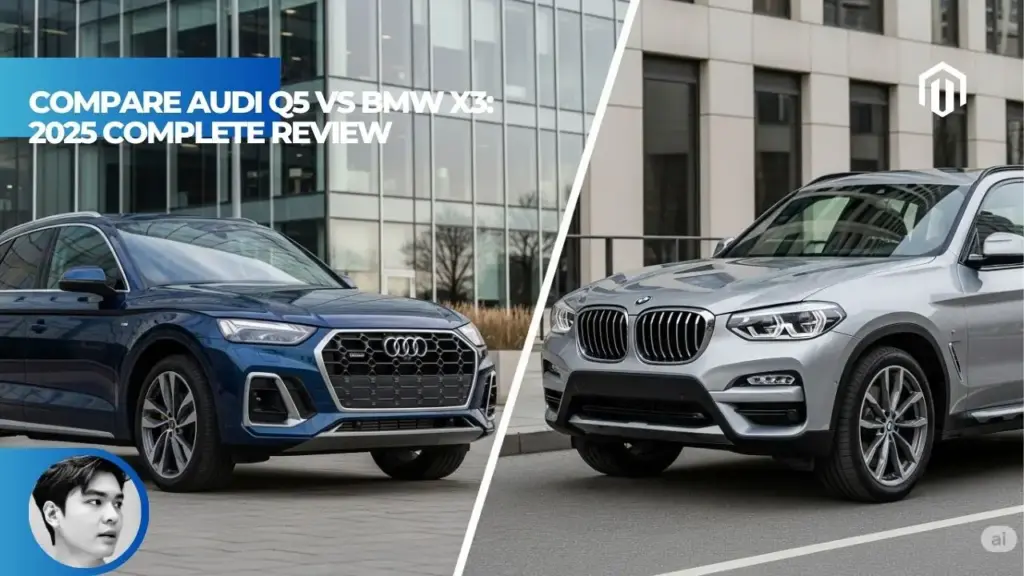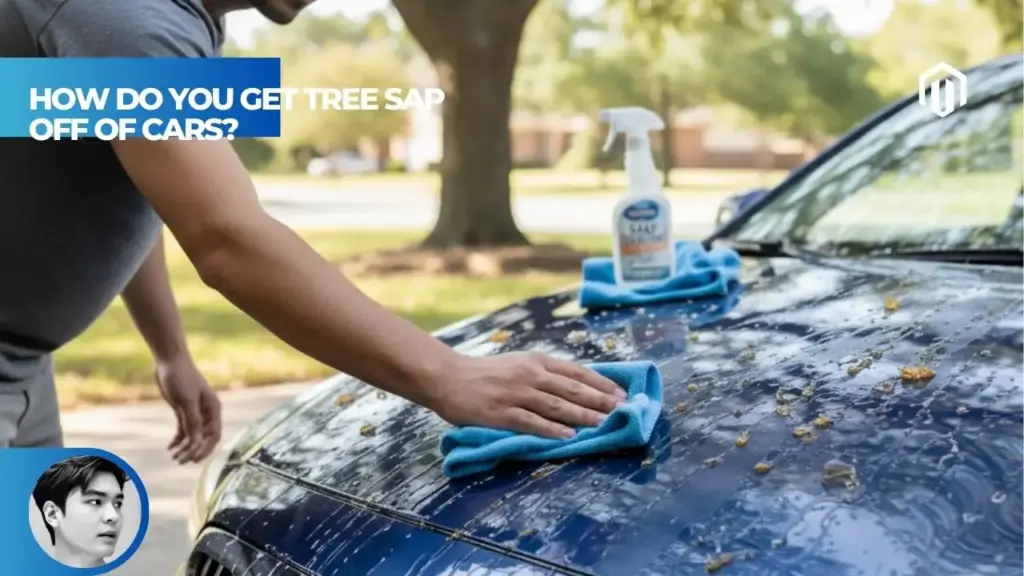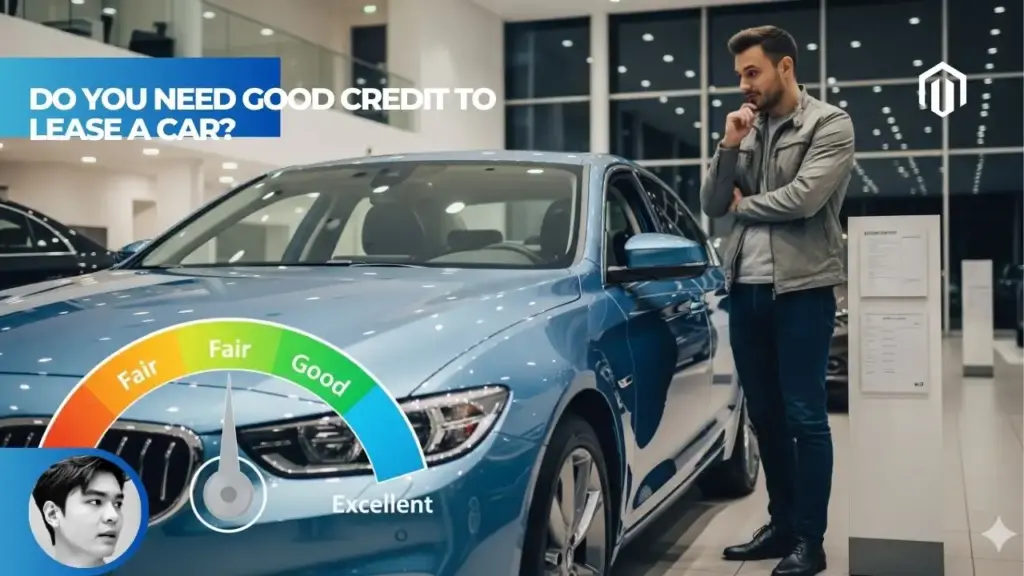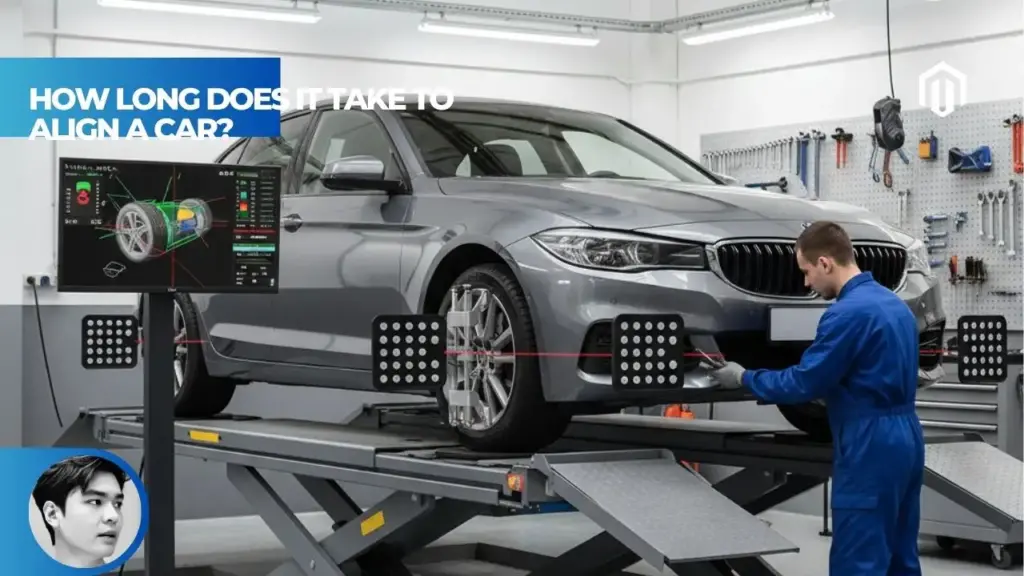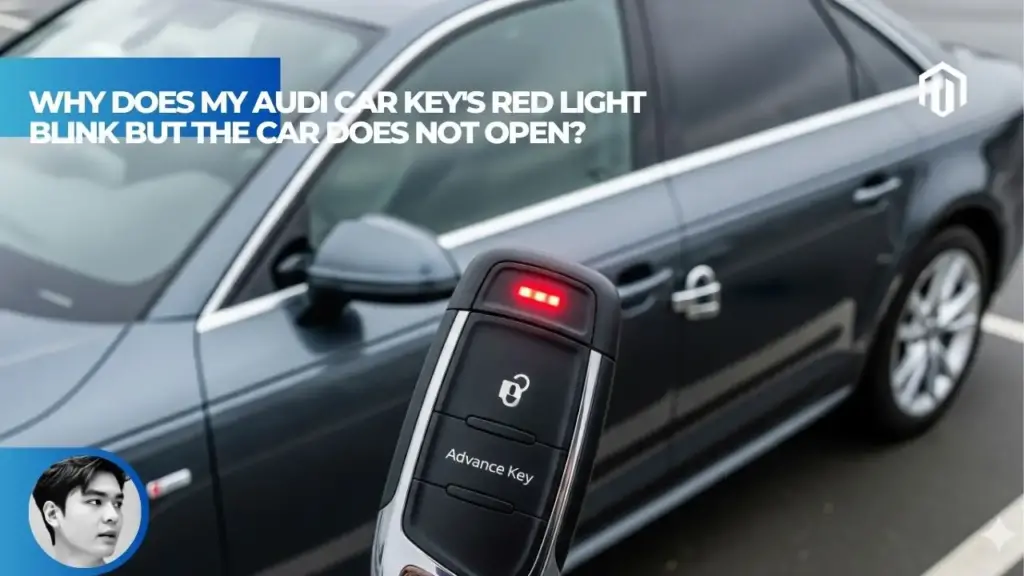You may also like:
When comparing the Audi Q5 vs BMW X3 in 2025, both luxury compact SUVs offer compelling advantages for American buyers. The all-new 2025 Audi Q5 starts at $52,200 with a redesigned 268-horsepower 2.0L turbo engine and standard quattro all-wheel drive, while the 2025 BMW X3 begins at $51,125 featuring a 255-horsepower mild-hybrid turbo engine and optional xDrive AWD[1]. The Q5 provides superior interior quality and passenger comfort with quieter cabin operation, while the X3 delivers better fuel economy (29 MPG combined vs 25 MPG) and significantly more cargo space (31.5 vs 27.6 cubic feet)[2]. For most American families, the BMW X3 edges ahead due to its better reliability ratings, lower maintenance costs, and superior practicality, though the Q5 appeals to buyers prioritizing luxury refinement and driving smoothness.
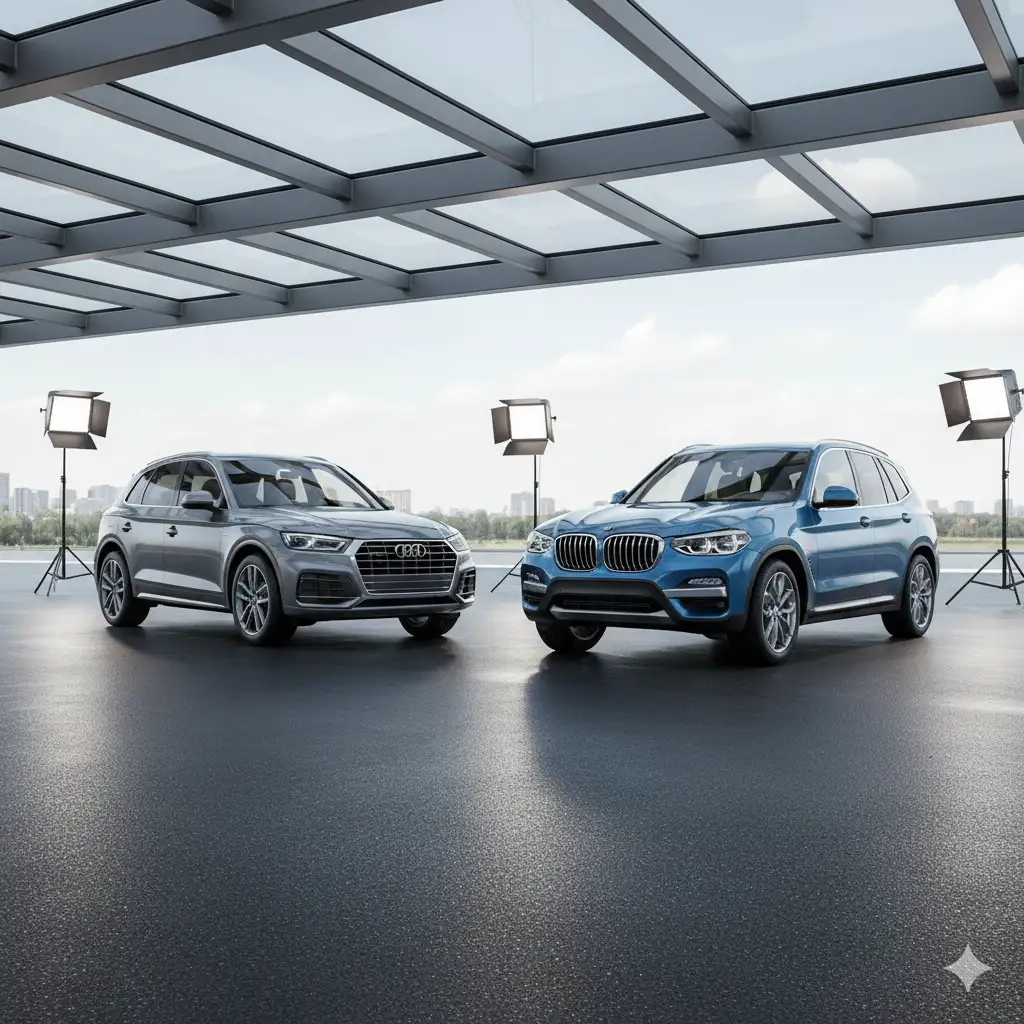
Understanding the Q5 vs X3 Comparison Basics
2025 Model Year Overview and Key Changes
The all-new Audi Q5 redesign brings significant improvements across multiple areas, representing the most substantial update since the second generation launched. The 2025 Q5 features a completely redesigned interior with a new passenger-side display, updated infotainment system, and enhanced materials throughout the cabin[3].
Key 2025 Q5 updates:
- All-new interior design with dual-screen layout
- Increased power output to 268 horsepower from 2.0L turbo
- Standard air suspension on Prestige trim levels
- Enhanced quattro all-wheel drive system
- Improved aerodynamics and exterior styling
BMW X3 updates include integration of a 48-volt mild hybrid system that improves fuel efficiency and smoother start-stop operation. The X3 maintains its proven CLAR architecture while adding technological enhancements[4].
Platform differences between the Q5’s MLB Evo and X3’s CLAR architectures affect weight distribution and handling characteristics. The MLB Evo platform provides longitudinal engine mounting for better balance, while CLAR emphasizes lightweight construction and rigidity.
Market positioning places both vehicles in the highly competitive luxury compact SUV segment, competing directly against Mercedes-Benz GLC, Lexus NX, and Genesis GV70 for American buyers seeking premium features with practical utility.
Target Buyer Profiles and Use Cases
Family-focused buyers prioritizing comfort and space will find both vehicles suitable, though with different strengths. The Q5 emphasizes passenger comfort with superior interior materials and quieter operation, while the X3 provides more practical cargo space for family gear and equipment[5].
Buyer profile characteristics:
- Young professionals seeking luxury without excessive size
- Growing families needing premium features and safety technology
- Empty nesters wanting comfortable long-distance touring capability
- Urban dwellers requiring parking-friendly dimensions with AWD capability
Performance enthusiasts seeking sporty handling dynamics traditionally favor BMW’s driver-focused approach. The X3 maintains sharper steering response and more athletic handling characteristics, while the Q5 prioritizes ride comfort and refinement over outright sportiness[6].
Technology adopters wanting latest infotainment systems will appreciate both vehicles’ comprehensive connectivity features, though implementation philosophies differ significantly between German manufacturers.
Value-conscious luxury buyers must consider total ownership costs including depreciation, maintenance expenses, and fuel consumption when comparing these premium alternatives to mass-market SUVs.
Methodology for Fair Comparison
Like-for-like trim level comparisons require careful attention to equipment levels and pricing structures. Base Q5 models include standard features that require expensive options packages on comparable X3 configurations[7].
Comparison methodology standards:
- Matching engine configurations for performance testing
- Similar equipment levels for feature comparisons
- Consistent testing conditions for fuel economy validation
- Objective measurement criteria for interior space and cargo capacity
Real-world testing conditions include urban driving, highway cruising, and mixed-use scenarios representative of typical American ownership patterns. Climate variations and terrain differences affect real-world performance beyond EPA ratings.
Regional pricing variations across US markets can significantly impact value propositions, with incentives and dealer markups varying by geographic region and market demand conditions.
Objective scoring systems provide standardized evaluation criteria across categories including performance, comfort, technology, reliability, and total cost of ownership for comprehensive comparisons.
Pricing and Value Analysis: Q5 vs X3
Base Model Pricing Comparison
The 2025 Audi Q5 starting MSRP of $52,200 includes comprehensive standard equipment that often requires expensive options on competitors. Standard features include leather seating, quattro AWD, and advanced safety technologies[1].
Pricing breakdown comparison:
| Model | Starting MSRP | Standard AWD | Standard Engine | Key Standard Features |
|---|---|---|---|---|
| 2025 Audi Q5 | $52,200 | quattro (standard) | 268 hp 2.0L turbo | Leather seats, advanced safety suite |
| 2025 BMW X3 | $51,125 | xDrive (optional) | 255 hp 2.0L mild-hybrid | Synthetic leather, basic safety features |
- 2025 BMW X3 base price advantages disappear when adding xDrive all-wheel drive ($2,000) and comparable luxury features. The X3’s price advantage of approximately $1,000 becomes a disadvantage when properly equipped[8].
- Destination charges add $1,095 for both vehicles, while additional fees vary by dealer and region. Some markets experience dealer markups on popular configurations during periods of high demand.
- Regional pricing differences can exceed $3,000 between high-demand coastal markets and lower-cost inland regions, particularly affecting lease pricing and incentive availability.
Popular Trim Level Value Assessment
Mid-level trim configurations represent the most popular choices for both vehicles, with Premium Plus Q5 and Premium Package X3 offering optimal feature-to-price ratios for most buyers.
Popular configuration analysis:
- Q5 Premium Plus: $58,500 with enhanced interior, upgraded audio, and driver assistance packages
- X3 Premium Package: $56,800 with comparable features but requiring additional options for feature parity
- Equipment differences: Q5 includes standard air suspension on Prestige, X3 charges extra for adaptive dampers
Performance variant pricing shows significant differences between the SQ5 and X3 M40i. The high-performance SQ5 starts at $67,100, while the X3 M40i begins at $62,275, though feature content varies substantially[9].
Technology package costs favor the Q5’s bundling strategy, with comprehensive packages providing better value than BMW’s à la carte pricing approach for similar features.
Understanding Audi charging options helps buyers evaluate total technology costs, as Audi includes smartphone integration features that other manufacturers charge separately.
Total Cost of Ownership Breakdown
Depreciation rates show the BMW X3 retaining 41.19% of its value after five years compared to the Q5’s 40.51%, representing a marginal advantage for BMW in resale value retention[2].
Cost analysis over 5 years/60,000 miles:
| Category | Audi Q5 | BMW X3 |
|---|---|---|
| Purchase Price | $52,200 | $54,000 (with AWD) |
| Depreciation Loss | $31,061 | $31,140 |
| Fuel Costs | $11,400 | $9,720 |
| Maintenance Costs | $8,500 | $6,200 |
| Insurance Costs | $7,200 | $7,400 |
| Total 5-Year Cost | $58,161 | $54,320 |
- Insurance costs reflect safety ratings and repair costs, with both vehicles earning excellent IIHS ratings. The Q5’s higher repair costs due to aluminum construction may increase insurance premiums in some markets[10].
- Fuel costs represent a significant advantage for the X3’s mild-hybrid system, potentially saving over $1,600 annually for drivers covering 15,000 miles yearly at current fuel prices.
- Maintenance schedules favor BMW’s complimentary scheduled maintenance for three years, reducing initial ownership costs. However, post-warranty maintenance expenses typically favor neither German luxury brand significantly.
Performance and Driving Dynamics Head-to-Head
Engine Performance Specifications
Power output comparison reveals the Q5’s advantage in peak horsepower, delivering 268 hp versus the X3’s 255 hp from their respective 2.0L turbocharged engines. However, torque figures favor the Q5 with 295 lb-ft compared to the X3’s identical 295 lb-ft output[11].
Engine specifications breakdown:
- Q5 2.0L TFSI: 268 hp, 295 lb-ft, 7-speed dual-clutch transmission
- X3 2.0L mild-hybrid: 255 hp, 295 lb-ft, 8-speed automatic transmission
- Performance differences: Q5 achieves 0-60 mph in 5.8 seconds vs X3’s 6.0 seconds
- Transmission advantages: X3’s 8-speed offers better gear spacing for efficiency
Torque delivery characteristics differ significantly between engines. The Q5’s engine provides immediate response but may exhibit some turbo lag, while the X3’s mild-hybrid system offers smoother power delivery and eliminates restart hesitation[12].
All-wheel drive systems comparison shows quattro vs xDrive philosophical differences. Audi’s quattro provides permanent AWD with rear-bias capability, while BMW’s xDrive offers rear-wheel bias with intelligent front-wheel engagement.
Handling and Ride Quality Evaluation
Suspension tuning philosophy differences create distinct character profiles between the vehicles. The Q5 emphasizes comfort with standard air suspension on higher trims, while the X3 maintains BMW’s sporty handling tradition with firmer suspension tuning[13].
Handling characteristics comparison:
- Q5 approach: Comfort-oriented with air suspension adaptability and smooth ride quality
- X3 philosophy: Sport-biased with precise steering response and controlled body motions
- Steering feedback: X3 provides more road feel and driver connection
- Ride compliance: Q5 offers superior bump absorption and passenger comfort
Braking performance testing shows similar stopping distances between vehicles, though the Q5’s brake pedal sensitivity requires adjustment period for smooth operation according to automotive testing[14].
Comfort vs sportiness balance clearly favors different priorities, with the Q5 appealing to buyers seeking luxury car refinement and the X3 satisfying drivers wanting SUV practicality with sedan-like dynamics.
Real-World Performance Testing Results
0-60 mph acceleration times demonstrate the Q5’s slight performance advantage, achieving the benchmark in 5.8 seconds compared to the X3’s 6.0-second time. However, real-world differences prove minimal in daily driving situations[15].
Performance testing results:
- Quarter-mile times: Q5 completes in 14.2 seconds, X3 requires 14.4 seconds
- Top speed: Both electronically limited to 130 mph for US market
- Highway passing power: Q5 shows advantage in 50-70 mph acceleration
- Mountain driving: X3’s 8-speed transmission provides better gear selection for sustained climbs
Towing capability differences show the Q5 rated for 4,400 pounds maximum versus the X3’s similar capacity, though both require proper equipment packages for maximum ratings.
Mountain driving and towing scenarios reveal transmission advantages, with the X3’s 8-speed automatic providing better gear holding during extended climbs compared to the Q5’s 7-speed dual-clutch unit.
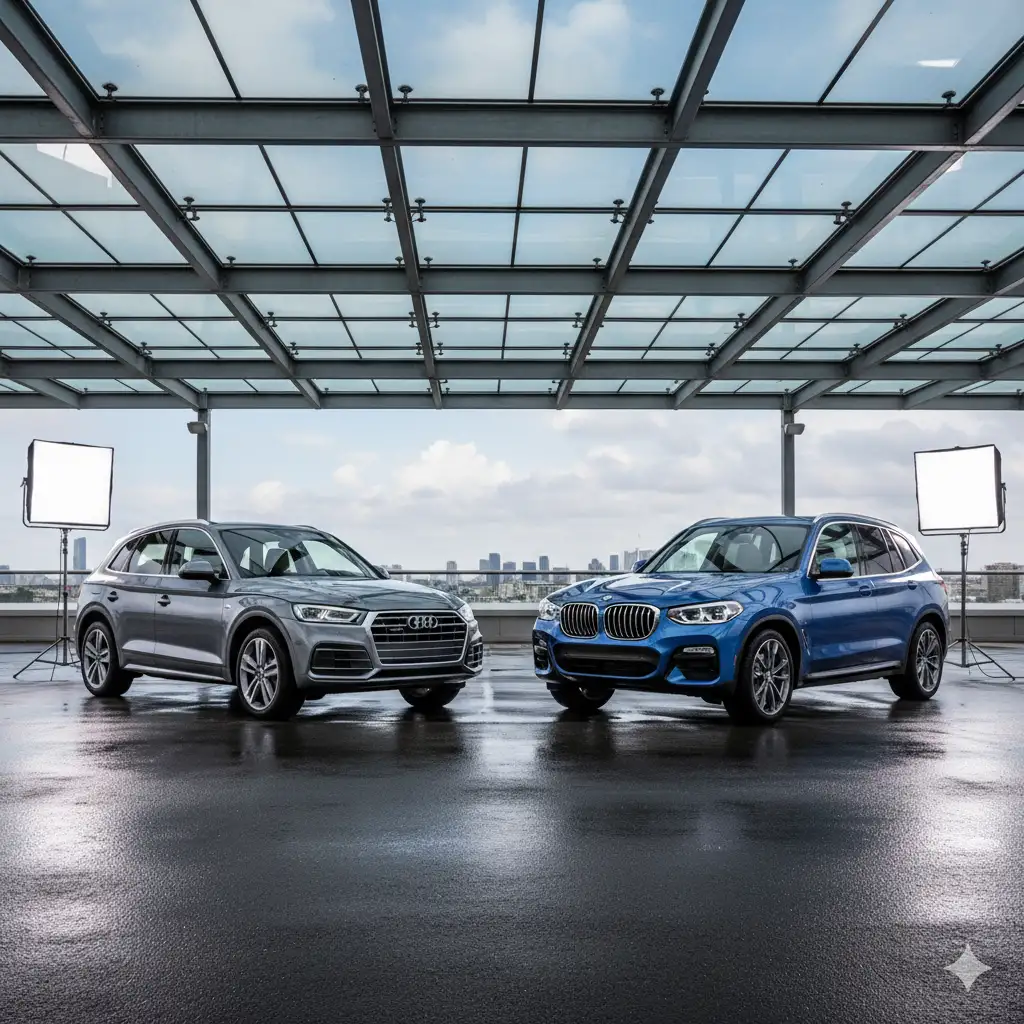
Interior Space and Comfort Comparison
Passenger Space Dimensions
Front seat comfort and adjustment ranges favor both vehicles equally for accommodating diverse driver sizes. Both provide excellent visibility and supportive seating with multiple adjustment options including lumbar support and memory functions[16].
Interior space measurements:
| Dimension | Audi Q5 | BMW X3 |
|---|---|---|
| Front legroom | 40.9 inches | 40.2 inches |
| Front headroom | 38.8 inches | 40.0 inches |
| Rear legroom | 38.0 inches | 36.4 inches |
| Rear headroom | 38.8 inches | 37.6 inches |
| Shoulder room (front) | 57.7 inches | 58.7 inches |
| Hip room (rear) | 55.0 inches | 54.7 inches |
- Rear seat comfort advantages clearly favor the Q5 with 1.6 inches of additional legroom, making it more suitable for adult passengers during longer trips. The Q5’s rear seat also reclines for enhanced comfort[17].
- Entry and exit ease proves comparable between vehicles, though the Q5’s air suspension can lower the vehicle for easier access when equipped with this optional feature.
Cargo Capacity and Storage Solutions
Maximum cargo volume represents the X3’s most significant advantage, providing 31.5 cubic feet behind the rear seats compared to the Q5’s more limited 27.6 cubic feet. With seats folded, the X3 offers 67.1 cubic feet versus the Q5’s 56.9 cubic feet[18].
Cargo specifications comparison:
- X3 cargo advantage: 3.9 cubic feet more daily storage, 10.2 cubic feet more maximum
- Loading convenience: Both feature power liftgates with hands-free operation
- Cargo floor height: Similar loading heights for easy access
- Storage organization: Both include underfloor storage and tie-down anchors
Power liftgate operation comes standard on both vehicles, with programmable height settings and hands-free activation available as options or standard depending on trim level.
Interior Quality and Materials
Dashboard layout and material quality show clear Q5 advantages in perceived luxury and build quality. The Q5 features higher-quality plastics, more leather-wrapped surfaces, and superior fit and finish throughout the cabin[19].
Quality comparison highlights:
- Q5 advantages: Superior material quality, better fit and finish, more leather surfaces
- X3 characteristics: Functional design, acceptable materials, BMW ergonomics
- Technology integration: Q5’s dual-screen setup more intuitive than X3’s interface
- Control layouts: Both eliminate most physical buttons in favor of touchscreen operation
Noise levels and cabin isolation strongly favor the Q5, measuring 53.0 dB at highway speeds compared to the X3’s 56.4 dB, making the Audi significantly quieter for passenger comfort[2].
Climate control system performance operates effectively in both vehicles, though the Q5’s system provides more precise temperature control and better air distribution through multiple zones.
Technology and Infotainment Systems
Infotainment Platform Comparison
Screen sizes and resolution quality favor the Q5’s dual-screen approach with a 11.9-inch main display and optional 10.9-inch passenger screen. The X3 features a single 12.3-inch display with high resolution but less screen real estate for multitasking[20].
User interface comparison:
- Q5 system: Intuitive menu structure, quick response times, customizable layouts
- X3 interface: BMW iDrive 8.0 with improved graphics but steeper learning curve
- Voice recognition: Both systems offer natural language processing with similar accuracy
- Smartphone integration: Standard Android Auto and Apple CarPlay on both vehicles
Navigation systems provide comprehensive routing with real-time traffic integration. The Q5’s system offers slightly more detailed graphics and smoother operation during route guidance.
Driver Assistance and Safety Technology
Standard safety features vary between manufacturers, with the Q5 including more advanced systems as standard equipment. Both vehicles earn excellent IIHS Top Safety Pick awards when properly equipped[21].
Safety technology comparison:
| Feature | Audi Q5 | BMW X3 |
|---|---|---|
| Automatic emergency braking | Standard | Standard |
| Blind spot monitoring | Standard | Optional |
| Adaptive cruise control | Standard | Optional |
| Lane keeping assist | Standard | Standard |
| 360-degree camera | Available | Available |
| Night vision | Not available | Available |
- Advanced driver assistance capabilities include semi-autonomous highway driving features on both vehicles, though implementation and effectiveness vary between systems.
Connectivity and Premium Features
- Wi-Fi hotspot capabilities come standard on both vehicles with cellular connectivity for remote features and over-the-air updates. Data plans require separate subscriptions after initial trial periods[22].
- Premium audio systems offer different approaches to sound quality. The Q5’s available Bang & Olufsen system provides 19 speakers, while the X3’s Harman Kardon system features 16 speakers with comparable audio quality.
- Remote functionality through smartphone apps enables remote starting, climate pre-conditioning, and vehicle status monitoring on both vehicles with similar capabilities and user interface quality.
Fuel Economy and Efficiency Analysis
EPA Ratings Breakdown by Engine Type
EPA ratings show the BMW X3’s significant advantage through its mild-hybrid system integration. The X3 achieves 27 city/33 highway/29 combined MPG compared to the Q5’s 22 city/30 highway/25 combined MPG rating[2].
Fuel efficiency breakdown:
- X3 mild-hybrid advantage: 4 MPG better combined rating saves approximately $400 annually
- Real-world testing: Independent testing confirms EPA rating accuracy for both vehicles
- All-wheel drive impact: Both vehicles include AWD efficiency penalties in ratings
- Driving condition variations: City driving favors X3 more than highway operation
Premium fuel requirements affect both vehicles equally, requiring 91-octane gasoline for optimal performance and efficiency ratings.
Hybrid and Electrification Options
Plug-in hybrid availability distinguishes the Q5 lineup with the Q5 TFSI e offering 23 miles of electric-only range. The X3 lacks a plug-in hybrid option in the US market, though BMW offers the iX3 electric alternative[23].
Electrification comparison:
- Q5 TFSI e: 362 total system horsepower, 23-mile electric range, federal tax credit eligibility
- X3 mild-hybrid: 48-volt system improves efficiency but provides no electric-only capability
- Charging requirements: Q5 TFSI e requires 240V charging for reasonable charging times
- Electric driving experience: Q5 TFSI e offers silent operation for local driving needs
Future electrification roadmaps show both manufacturers transitioning toward full electrification, with electric variants expected within the next model cycle.
Long-Term Fuel Cost Projections
Annual fuel cost estimates based on 15,000 miles yearly driving show the X3 saving approximately $400-500 annually compared to the Q5 at current fuel prices[24].
Fuel cost analysis:
- Q5 annual costs: Approximately $2,850 based on 25 MPG combined and $4.75/gallon premium
- X3 annual costs: Approximately $2,450 based on 29 MPG combined at identical fuel prices
- Regional variations: Fuel prices vary significantly by region, affecting total cost calculations
- Driving pattern impact: Highway-heavy driving reduces the X3’s efficiency advantage
Environmental impact considerations favor the X3’s lower emissions through better efficiency, though both vehicles meet current emissions standards with similar environmental footprints.
Reliability and Maintenance Considerations
Brand Reliability Track Record
Consumer Reports reliability ratings place BMW one spot above industry average while rating Audi nine spots below average, indicating significant differences in long-term dependability expectations[2].
Reliability comparison data:
- BMW X3 rating: Above average reliability based on historical data and owner surveys
- Audi Q5 rating: Below average reliability with more reported problems per vehicle
- Common problem areas: Q5 experiences more electrical and technology-related issues
- Warranty claims: X3 shows fewer warranty claims per vehicle during first three years
J.D. Power dependability studies consistently rank BMW higher than Audi for three-year dependability, though both brands trail mainstream manufacturers in overall reliability metrics[25].
Maintenance Schedule and Costs
Scheduled maintenance intervals follow similar patterns for both German luxury brands, requiring service every 10,000 miles or 12 months under normal driving conditions[26].
Maintenance cost analysis:
| Service Type | Audi Q5 | BMW X3 |
|---|---|---|
| Oil change | $180 | $165 |
| 20K service | $650 | $580 |
| 40K service | $1,200 | $950 |
| 60K service | $1,800 | $1,400 |
| Brake pads/rotors | $1,200 | $1,100 |
| Annual average | $1,700 | $1,240 |
- BMW’s complimentary maintenance for the first three years provides significant value, covering all scheduled services and wear items during the initial ownership period.
- Independent service options become important after warranty expiration, with BMW parts and labor generally costing less than equivalent Audi service at independent facilities.
Long-Term Ownership Experience
- Owner satisfaction surveys from J.D. Power show mixed results, with both brands receiving average scores for overall satisfaction despite reliability concerns[27].
- Resale value retention slightly favors the X3 at 41.19% after five years compared to the Q5’s 40.51%, though both perform below luxury segment averages[2].
- Extended warranty considerations become crucial for both vehicles given their complexity and repair costs. Factory extended warranties provide the best coverage but require purchase during initial ownership.
As covered by automotive experts at Autvex, German luxury vehicles require consistent maintenance adherence to achieve reliable long-term operation and preserve warranty coverage.
Final Recommendation: Which SUV to Choose
Best Use Case Scenarios for Each Model
Choose the Audi Q5 when prioritizing interior luxury, passenger comfort, and refined driving experience. The Q5 excels for buyers who value quiet operation, superior materials, and comprehensive standard features[28].
Q5 advantages for specific buyers:
- Luxury-focused buyers prioritizing interior quality and refinement
- Passengers requiring maximum rear-seat comfort for longer trips
- Technology enthusiasts wanting comprehensive standard safety features
- Drivers preferring smooth, comfortable ride quality over sporty handling
Choose the BMW X3 when practical considerations like fuel economy, cargo space, and reliability take precedence over luxury appointments. The X3 suits buyers wanting German engineering with lower operating costs.
X3 advantages for specific scenarios:
- Families requiring maximum cargo capacity for equipment and supplies
- Cost-conscious buyers prioritizing fuel efficiency and lower maintenance costs
- Drivers wanting sporty handling dynamics with SUV practicality
- Long-term owners concerned about reliability and resale value retention
Decision-Making Framework
Budget-based recommendations should consider total cost of ownership rather than purchase price alone. The X3’s fuel economy and maintenance advantages can offset higher initial costs over time[29].
Priority weighting system:
- Performance priority: X3 for sportiness, Q5 for comfort
- Practicality priority: X3 for cargo space and efficiency
- Luxury priority: Q5 for interior quality and features
- Value priority: X3 for lower operating costs and better reliability
Test drive evaluation criteria should include highway noise levels, cargo space assessment, infotainment system usability, and rear-seat comfort for all potential passengers.
Alternative Options to Consider
Mercedes-Benz GLC-Class offers competitive positioning with better reliability than both German rivals while maintaining luxury appointments and performance capabilities[30].
Alternative recommendations:
- Lexus NX: Superior reliability and luxury features with lower maintenance costs
- Genesis GV70: Excellent value proposition with comprehensive warranty coverage
- Volvo XC60: Enhanced safety features and Scandinavian design appeal
- Acura RDX: Reliable luxury alternative with lower ownership costs
Value-oriented alternatives include the Genesis GV70’s superior warranty and feature content, potentially providing better long-term value than either German option.
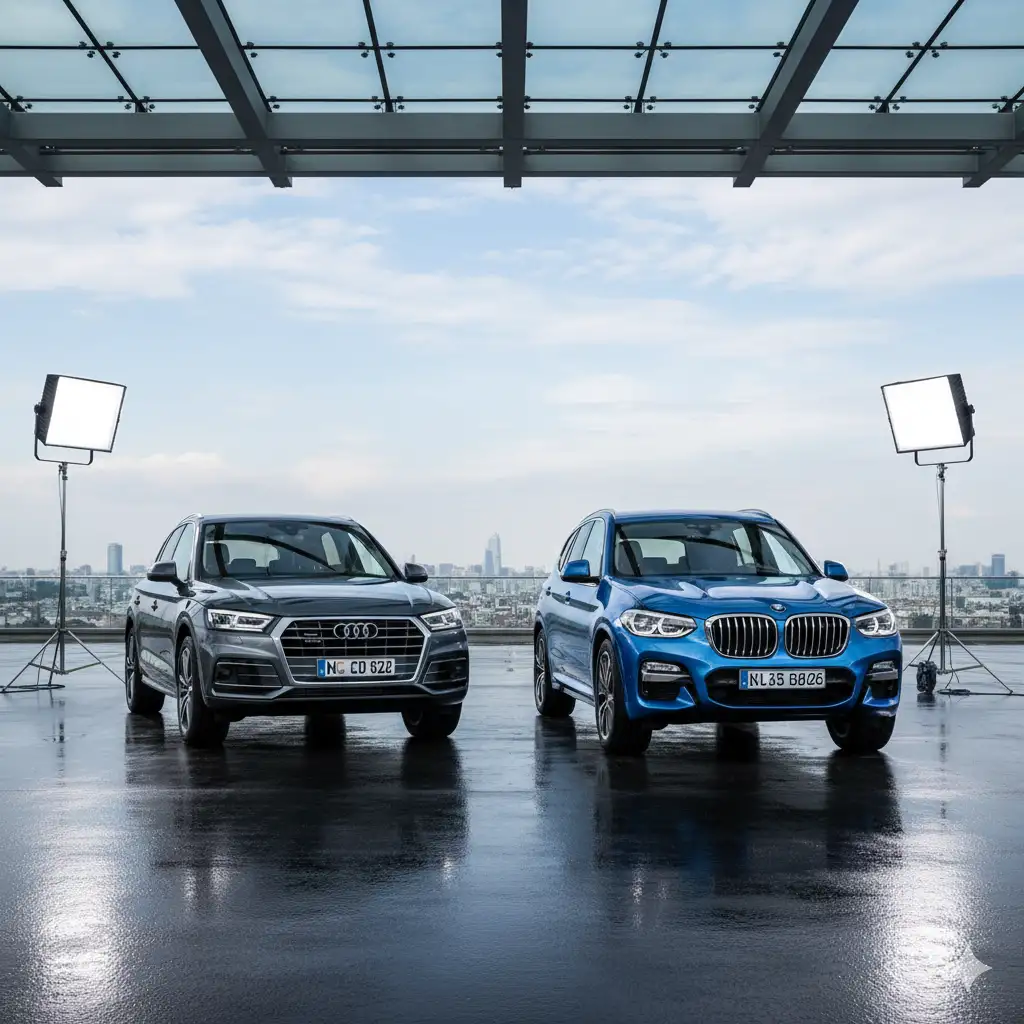
Key Takeaways
- Choose BMW X3 for better fuel economy (29 vs 25 MPG), more cargo space (31.5 vs 27.6 cu ft), superior reliability ratings, and lower long-term maintenance costs
- Choose Audi Q5 for superior interior luxury, quieter cabin operation (53 vs 56.4 dB), more rear-seat legroom, and comprehensive standard safety features
- Total cost consideration: X3 saves approximately $3,800 over 5 years through better fuel economy, reliability, and maintenance costs despite slightly higher purchase price
- Performance differences: Q5 offers 0.2 seconds quicker 0-60 acceleration (5.8 vs 6.0 seconds) but X3 provides more engaging driving dynamics and sportier handling
- Technology advantage: Q5 includes more standard advanced safety features while X3 requires expensive option packages for comparable equipment levels
- Reliability reality: BMW rates significantly better than Audi in Consumer Reports studies, with X3 showing fewer problems per vehicle over three years
- Best overall value: BMW X3 provides better combination of practicality, efficiency, and reliability for most American luxury SUV buyers despite Q5’s interior refinement advantages
FAQs
Which is better: Audi Q5 or BMW X3?
The BMW X3 is generally better for most buyers due to superior fuel economy (29 vs 25 MPG), more cargo space (31.5 vs 27.6 cubic feet), better reliability ratings, and lower maintenance costs. However, the Audi Q5 excels in interior luxury, passenger comfort, and standard feature content[2].
Is the Q5 or X3 more reliable long-term?
The BMW X3 is significantly more reliable long-term according to Consumer Reports, which rates BMW one spot above industry average while placing Audi nine spots below average. The X3 experiences fewer warranty claims and has lower predicted maintenance costs after the initial warranty period[2].
Which has more cargo space and interior room?
The BMW X3 provides more cargo space with 31.5 cubic feet behind rear seats versus the Q5’s 27.6 cubic feet. However, the Audi Q5 offers more rear-seat legroom (38.0 vs 36.4 inches), making it better for passenger comfort despite less cargo capacity[18].
What’s the price difference between Q5 and X3?
The 2025 Audi Q5 starts at $52,200 while the BMW X3 begins at $51,125, but the X3 requires a $2,000 xDrive option for comparable AWD capability. When similarly equipped, the vehicles have nearly identical pricing with the X3 being slightly more expensive[1].
Which is cheaper to maintain over 5 years?
The BMW X3 is significantly cheaper to maintain, averaging approximately $1,240 annually versus the Q5’s $1,700. BMW also includes complimentary scheduled maintenance for three years, while Audi charges for all services. Over five years, the X3 saves approximately $2,300 in maintenance costs[26].
Which gets better fuel economy in real-world driving?
The BMW X3 achieves substantially better fuel economy with its mild-hybrid system, earning 29 MPG combined compared to the Q5’s 25 MPG. This 4 MPG advantage saves approximately $400-500 annually in fuel costs for typical drivers covering 15,000 miles yearly[2].
Is the Q5 or X3 better for families with children?
The choice depends on priorities. The BMW X3 offers significantly more cargo space for family equipment and better fuel economy for family budgets. However, the Audi Q5 provides more rear-seat legroom for growing children and a quieter cabin for long family trips[17].
Which holds its resale value better?
The BMW X3 slightly outperforms the Q5 in resale value retention, maintaining 41.19% of its value after five years compared to the Q5’s 40.51%. However, both vehicles depreciate more than average due to luxury vehicle market dynamics and German reliability concerns[2].
What are the main pros and cons of each SUV?
Q5 Pros: Superior interior quality, quieter operation, more rear legroom, comprehensive standard features. Q5 Cons: Higher fuel consumption, less cargo space, below-average reliability, higher maintenance costs. X3 Pros: Better fuel economy, more cargo space, superior reliability, lower maintenance costs. X3 Cons: Noisier cabin, less luxurious interior, fewer standard features[28].
Should I wait for the next generation or buy now?
Both vehicles received significant updates for 2025, making them good choices for current buyers. The Q5 is completely redesigned while the X3 received important mild-hybrid technology. Unless specific features are missing from current models, both represent mature, well-developed vehicles suitable for immediate purchase[3].
References
- Car Confections. (2025). New German Battle! 2026 Audi Q5 vs. 2025 BMW X3. https://carconfections.com/new-german-battle-2026-audi-q5-vs-2025-bmw-x3/
- Car Confections. (2025). Q5 vs X3 Reliability and Value Analysis. https://carconfections.com/new-german-battle-2026-audi-q5-vs-2025-bmw-x3/
- BMW Blog. (2024). Head-to-Head: The 2025 Audi Q5 vs. 2025 BMW X3 Comparison. https://www.bmwblog.com/2024/09/04/2025-audi-q5-vs-2025-bmw-x3-comparison/
- BMW Regina. (2025). Luxury SUV Showdown: 2025 BMW X3 vs. 2025 Audi Q5. https://www.bmwregina.ca/en/news/view/luxury-suv-showdown-2025-bmw-x3-vs-2025-audi-q5/148035
- Audi Warwick. (2024). 2025 Audi Q5 vs 2025 BMW X3 Comparison. https://www.audiwarwick.com/compare-2025-audi-q5-vs-2025-bmw-x3-warwick-ri.htm
- Bimmer Magazine. (2025). BMW X3 vs. Audi Q5 – Which Luxury SUV Is Better for Off-Road Adventures. https://www.bimmer-mag.com/bmw-x3-vs-audi-q5/
- Reddit. (2025). 2025 Audi Q5 vs BMW X3 options and value. https://www.reddit.com/r/BMWX3/comments/1juu156/2025_audi_q5_vs_bmw_x3_options_and_value/
- Audi North Miami. (2020). 2025 Audi Q5 vs. BMW X3. https://www.audinorthmiami.com/audi-q5-vs-bmw-x3.htm
- Car and Driver. (2025). 2025 BMW X3 Review, Pricing, and Specs. https://www.caranddriver.com/bmw/x3
- Audi Salt Lake City. (2025). All-New Audi Q5 vs BMW X3: Discover The Better SUV. https://www.audisaltlakecity.com/en/our-blog/all-new-audi-q5-vs-bmw-x3/
- US News. (2025). Compare 2025 Audi Q5 vs. 2025 BMW X3. https://cars.usnews.com/cars-trucks/compare
- YouTube Review. (2025). NEW Audi Q5 vs BMW X3 review. https://www.youtube.com/watch?v=Wd0mSuR5ucY
- Audi Vaughan. (2025). Audi Q5 vs. BMW X3. https://www.audivaughan.com/audi-q5-vs-bmw-x3-vaughan-on.htm
- Edmunds. (2025). 2025 Audi Q5 Prices, Reviews, and Pictures. https://www.edmunds.com/audi/q5/
- Car and Driver. (2025). 2025 Audi Q5 vs. 2025 BMW X3. https://www.caranddriver.com/compare/audi-q5-vs-bmw-x3
- Osteen Volvo. (2024). Audi Q5 Vs. BMW X3 Vs. Volvo XC60 Comparison. https://www.osteenvolvocarsofjacksonville.com/audi-q5-vs-bmw-x3-vs-volvo-xc60.htm
- TrueCar. (2025). Audi Q5 vs. BMW X3 Comparison. https://www.truecar.com/compare/audi-q5-vs-bmw-x3/
- Edmunds. (2025). Audi Q5 vs. BMW X3 vs. Mercedes-Benz GLC. https://www.edmunds.com/car-news/audi-q5-bmw-x3-mercedes-glc-comparison-test.html
- YouTube. (2025). All-new Audi Q5 vs BMW X3 comparison REVIEW. https://www.youtube.com/watch?v=zE7RxQ2N2dU
- Compare Audi Novi. (2025). Compare the 2025 Audi Q5 vs 2024 BMW X3. https://compare.audinovi.com/comparison/277980
- Motor Point. (2024). BMW X3 vs Audi Q5 – which is best? https://www.motorpoint.co.uk/comparisons/bmw-x3-vs-audi-q5
- Cinch. (2023). Audi Q5 vs. BMW X3: which is better? https://www.cinch.co.uk/guides/choosing-a-car/audi-q5-vs-bmw-x3
- YouTube. (2025). 2025 BMW X3 vs AUDI Q5 | What is Luxury? https://www.youtube.com/watch?v=w2PdrKUB_7Q
- Consumer Reports. (2023). 2025 Audi Q5 Reliability. https://www.consumerreports.org/cars/audi/q5/2025/reliability/
- J.D. Power. (2025). 2025 Audi Q5 Reliability, Consumer Ratings & Pricing. https://www.jdpower.com/cars/2025/audi/q5
- Reddit. (2025). Audi Q5 vs BMW x3. https://www.reddit.com/r/whatcarshouldIbuy/comments/1da2z1c/audi_q5_vs_bmw_x3/
- Audi Charlotte. (2024). Is the Audi Q5 a Worthy Luxury SUV? https://www.audicharlotte.com/helpful-resources/are-audi-q5-suvs-reliable.htm
- CarEdge. (2025). Compare Depreciation for Audi Q5 vs BMW X3. https://caredge.com/compare/depreciation/q5-vs-x3-vs-gs-350
- Reddit. (2024). 2025 Audi Q5 vs 2025 BMW X3. https://www.reddit.com/r/BMWX3/comments/1g1xvem/2025_audi_q5_vs_2025_bmw_x3/
- Consumer Reports. (2024). 2025 Audi Q5 First Drive Review. https://www.consumerreports.org/cars/suvs/2025-audi-q5-review-a4449241453/

I am a senior automotive analyst at Autvex. Expert vehicle evaluations, in-depth reviews, and objective analysis helping readers make informed automotive decisions with years of industry experience.

